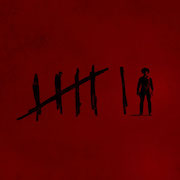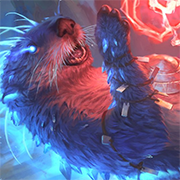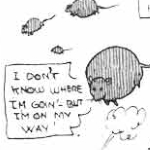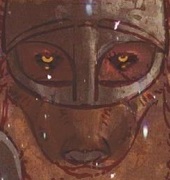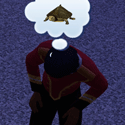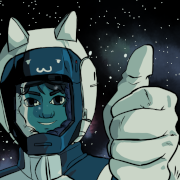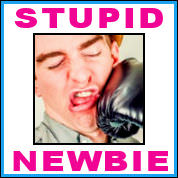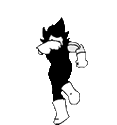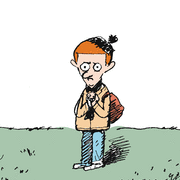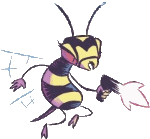|
Mors Rattus posted:In Nomine: Everything Under Heaven I always had a tough time keeping those two concepts distinct, because they were both "musical terms starting with dis- that you get when you aren't as good/bad as you're supposed to be". I kind of wish they just had a single system for tracking that kind of damage rather than making dissonance to Discord a one-way transfer.
|
|
|
|

|
| # ? Apr 19, 2024 22:24 |
|
Nessus posted:I think it wasn't really planned as a "line" at all, and has only become one because there was somewhat more demand than expected. All the same, by the time they got to Mage there's zero excuse not to have some sort of coherent style guide for the line, or at very least for an editor to lean over and manage compatibility. Asimo posted:The In Nomine writeup reminds me that while I never minded Dan Smith's B&W art in like the thousand different GURPS books he did, his color art was really bad. Or at least whoever colored over his silhouette work did a lovely job of it. Yeah, it's really, really awful. (Why would one color his really terrible signature pink so the eye goes right to it?)
|
|
|
|
LatwPIAT posted:I've been under the impression that the World of Darkness games sold themselves on their simplicity and elegance, but this is detail and fidelity that competes with GURPS. New World of Darkness, maybe. As bad as the merit bloat can get (And 2nd edition has helped with that by just giving out more dots), they kept skills under control with the specialization system. Alien Rope Burn posted:All the same, by the time they got to Mage there's zero excuse not to have some sort of coherent style guide for the line, or at very least for an editor to lean over and manage compatibility. "Editor", is that some type of minor character template from a supplement they forgot to include?  Reading this, I'm starting to think that Beast was not some huge misstep and that Onyx Path is slipping back into White Wolf's lovely old ways.
|
|
|
|
Kavak posted:Reading this, I'm starting to think that Beast was not some huge misstep and that Onyx Path is slipping back into White Wolf's lovely old ways. It just feels like there's just no strong editorial direction. Even in a generally solid book like Werewolf: the Forsaken 2e I had to go back to the previous edition to try and figure out how / why a werewolf is a member of a tribe. It seems to be more on the quality of the writers involved to make sure things come together well.
|
|
|
|
Kavak posted:"Editor", is that some type of minor character template from a supplement they forgot to include? Honestly Beast was really out of left field for everyone. BHM's previous book was Demon, which is god-machine damned amazing. But he also had someone else writing with him on that one. I know Rose and Rich raised their concerns after the Beast Kickstarter feedback was the equivalent of "Oh hell no!" but Matt really stuck to his guns with how he wanted Beast to go. Demon recently had a new release with it's Storytellers Guide and it's apparently a return to form. Kurieg fucked around with this message at 07:03 on Jan 15, 2016 |
|
|
|
Kurieg posted:Demon recently had a new release with it's Storytellers Guide and it's apparently a return to form. The STG has some rough patches (Incepts!) but has some really amazing parts, too (Giants!).
|
|
|
|
Alien Rope Burn posted:It just feels like there's just no strong editorial direction. Even in a generally solid book like Werewolf: the Forsaken 2e I had to go back to the previous edition to try and figure out how / why a werewolf is a member of a tribe. It seems to be more on the quality of the writers involved to make sure things come together well. I was somewhat horrified to read the writer's guide for nChangeling 2E and discover that it included things like "don't care too much about edge cases, we expect the STs to handle that" (paraphrased) and "I don't want more than 300 words on specific Tilts - instead there'll be a system for making Tilts" (paraphrased, but with less uncharitable interpretation this time). They seem to offload a lot of the development and even quality control on the STs, rather than providing rigorous and elegant mechanics - and I know they can do better; the WoD games have often been full of interesting emergent mechanics that help to create stories from simple interactions. One of my favourite examples is how Willpower and Vice interact in World of Darkness, where you need to spend Willpower to do difficult ~stuff~ and the best way to regain Willpower is to invoke your Vice. The result is that characters who face adversity get stressed and are tempted to succumb to their vices a lot, because investigating the supernatural is stressful and going out and getting drunk, starting a fight, or having a one-night stand is tempting.
|
|
|
|
LatwPIAT posted:They seem to offload a lot of the development and even quality control on the STs, rather than providing rigorous and elegant mechanics I find in general this is to more rules light/plot based games as 'Eh, they'll houserule it to balance' is to crunchy ones.
|
|
|
Grnegsnspm posted:It was also our Second Episode of System Mastery. Which we only did because I was super interested to see what the hell you would do in a Buffy RPG. Slay vampires? Buffy's the show that made research look fun. Count Chocula fucked around with this message at 08:13 on Jan 15, 2016 |
|
|
|
|
Count Chocula posted:Slay vampires? Yeah but "slay vampires" was just one person's thing. Like everyone that wasn't the Slayer was mostly there to be snarky, half-assedly look up demons in old books, and fall in love with monsters. I was genuinely curious if they were going to go with an "everyone is a slayer/supernatural" route or if it was like "One person gets to be cool and everyone else is a bystander". I think they handled the split pretty well, all things considered.
|
|
|
quote:Legend: You can channel the essence of a legend of pop-culture icon. This lets you, once per story, roll [Legend] to get Quintessence back. The difficulty of this roll is based on how well-known the legend is. The more dots you have, the less obscure the legend is, so having few dots in Legend makes it pretty useless... though 1 dot gives you access to pop-culture icons like Grumpy Cat. On the legend side of things, for 1 dot you can channel the legend of Abou Hassan. For 2 dots, you can channel a significant pop-culture figure like Janis Joplin (...who?), while 3 dots lets you channel Batman and Elvis. At 4 dots you can channel a major legend like Geronimo (...uh, who?) or Red Riding Hood, while 5 dots are "A universally popular legend" like Cinderella or King Arthur. Does anyone else think this is a bit patronizing and culturally provincial? This Abou Hassan guy, who apparently has a million restaurants named after him is a 1-dot Legend, while obscure figures from US history like Geronimo are 4-dot Legends and western fairy tales and literary canon like Cinderella and King Arthur are 5 dots. Frankly, Batman is probably more well-known than Cinderella. I always liked this background (I think my voodoo blues guy picked Robert Johnson, obvious as that is) but it sounds like it deserves to be its own game, not buried in the Backgrounds section. You could build an entire game out of the concept of channeling pop culture and mythic icons. Scion kinda does it, and Unknown Armies builds a large chunk of the game out of Avatars, but this is more like that game's Iconomancy. I just want a whole game where one guy channels Elvis' charisma, the combat monster as Bruce Lee's Totem, and it's all funded by the King Creosote channeler. And you could use artifacts touched by that person's life or related to them to get more power. Oh and Janis Joplin: http://m.youtube.com/watch?v=7uG2gYE5KOs It's probably pretty disrespectful, but I imagine a Geronimo!!!!! totem going around Leroy Jenkinsing everywhere, yelling GERONIMO!!! and comstantky looking for planes to jump out of. I dunno if you can get annoyed at RPGs for referencing things you don't know - it could be a good jumping-off point to learn about things like The Comte De St Germain and glaive-guissarmes, and popular 60s singers. Count Chocula fucked around with this message at 09:21 on Jan 15, 2016 |
|
|
|
|
Kavak posted:Reading this, I'm starting to think that Beast was not some huge misstep and that Onyx Path is slipping back into White Wolf's lovely old ways. The running gag in my gaming group when we discuss these train wrecks is "White Wolf. White Wolf never changes." LatwPIAT posted:I was somewhat horrified to read the writer's guide for nChangeling 2E and discover that it included things like "don't care too much about edge cases, we expect the STs to handle that" (paraphrased) and "I don't want more than 300 words on specific Tilts - instead there'll be a system for making Tilts" (paraphrased, but with less uncharitable interpretation this time). They seem to offload a lot of the development and even quality control on the STs, rather than providing rigorous and elegant mechanics - and I know they can do better; the WoD games have often been full of interesting emergent mechanics that help to create stories from simple interactions. One of my favourite examples is how Willpower and Vice interact in World of Darkness, where you need to spend Willpower to do difficult ~stuff~ and the best way to regain Willpower is to invoke your Vice. The result is that characters who face adversity get stressed and are tempted to succumb to their vices a lot, because investigating the supernatural is stressful and going out and getting drunk, starting a fight, or having a one-night stand is tempting.
|
|
|
|
I was planning on putting this in the next actual post for Hoodoo Blues (which may or may not come after a Technomancer one), but Evil Mastermind's recent post about TORG's short fiction gave me a perfect excuse to do it now. Each character class has a short piece of fiction connected to it, and they're almost all really, really bad. It's one of of the few things that stick out to me as major flaws of the book.Medicine Worker Short Fiction posted:Those who had seen them together in the casinos and the clubs assumed from their appearance that Thunder was either a john or a sugar-daddy. He appeared to be a Native American in his 80s. She appeared to be a Black woman half his age. She wore a tank-top and jeans that showed off her curviness. He has a tailored suit and thick money-roll. There were few other conclusions anyone could reach. Voodoo Short Fiction posted:“Those of us with actual pride in our actual heritage don’t pick and choose, we’re proud of the bits we brought over from Africa, we’re proud of the bits we stole form the Indians and we’re even proud of the bits imposed on us by the White man. We don’t need to dress our religion up as something it ain’t or censor the bits that aren’t currently politically correct.” Fossilized Rappy fucked around with this message at 10:55 on Jan 15, 2016 |
|
|
|
Fossilized Rappy posted:I'm not exactly sure why there's such a disconnect between the actual game text and the short fiction, but it's really jarring every time. You ever read the Vampire the Requiem source book Damnation City? Same thing- fantastic city-building tools on the crunch side, B vs. D on the fluff.
|
|
|
|
The basic Cinderella story is probably one of the most popular fairy tales in the world- there are variants of it in Korea and China (And some folklorists are pretty sure that Cinderella started with the Chinese folktale and migrated west before Perrault established the modern version), several Native American stories that are similar (Though they usually involve marrying some sort of spirit or hero instead of a prince, obviously.) etc. If you're going to pick a story to be a five dot legend, you could do worse.
|
|
|
Kavak posted:You ever read the Vampire the Requiem source book Damnation City? Same thing- fantastic city-building tools on the crunch side, B vs. D on the fluff.
|
|
|
|
|
senrath posted:You mean what's coming this year? Yeah, that's what I was thinking of. I just hope the system isn't dogshit.
|
|
|
|
chiasaur11 posted:I can believe it. The Asyle sourcebook has a fiction piece that is eight page long that describes how magic works. Eight. Pages. Eight.
|
|
|
|
LatwPIAT posted:I was somewhat horrified to read the writer's guide for nChangeling 2E and discover that it included things like "don't care too much about edge cases, we expect the STs to handle that" (paraphrased) and "I don't want more than 300 words on specific Tilts - instead there'll be a system for making Tilts" (paraphrased, but with less uncharitable interpretation this time). They seem to offload a lot of the development and even quality control on the STs, rather than providing rigorous and elegant mechanics - and I know they can do better; the WoD games have often been full of interesting emergent mechanics that help to create stories from simple interactions. One of my favourite examples is how Willpower and Vice interact in World of Darkness, where you need to spend Willpower to do difficult ~stuff~ and the best way to regain Willpower is to invoke your Vice. The result is that characters who face adversity get stressed and are tempted to succumb to their vices a lot, because investigating the supernatural is stressful and going out and getting drunk, starting a fight, or having a one-night stand is tempting. In Beast the mechanical bits, such as they are, are somewhat well put together. The Atavisms and Nightmares are really good and evocative. But the fluff put together around those mechanics is what kills it. It's one of those things where you think a competent writer could probably come in and salvage it given the opportunity, except a competent writer was given that opportunity, and he was forced to take it by the Kickstarter Backers. He just didn't change anything that mattered, it still has vile enemies such as "Pick Up Artist" and "Conservative Mother" and goes on at length about how everybody loves you because you're so perfect and special and anyone who says otherwise deserves to die.
|
|
|
|
Evil Mastermind posted:The Asyle sourcebook has a fiction piece that is eight page long that describes how magic works. I didn't know Brandon Sanderson worked on TORG before starting his regular writing career.
|
|
|
|
unseenlibrarian posted:I didn't know Brandon Sanderson worked on TORG before starting his regular writing career. quote:The brass hinges on the door squeaked loudly, announcing Mathea’s entrance into the classroom. The murmur of conversation died the instant she crossed the threshold, her appearance as effective as any silence spell ever cast. She moved quietly to the podium, setting down her notes and her hindsight bowl. She unstoppered her flask, emptied water into the bowl, and uttered a spell. She faced the class, looked sideways at the bowl, and an image of a whiteboard appeared behind her. Another spell, and a colored marker began to write for all to see:
|
|
|
|
Count Chocula posted:I dunno if you can get annoyed at RPGs for referencing things you don't know - it could be a good jumping-off point to learn about things like The Comte De St Germain and glaive-guissarmes, and popular 60s singers. I don't, by itself, mind that the book references things I don't know. I just find the examples used to be particularly striking in their obscurity; a "significant pop-culture figure" is someone who until reading M20 I had never heard of. Geronimo is rated above Elvis and Batman. These examples are supposed to provide context and guidelines, but to me they fail to do so. I know who Grumpy Cat is, I don't know who Janis Joplin is. I know more about Elvis than Geronimo. This makes it very hard for me - and I reckon I'm not alone in this - to determine where on this scale something falls. Is Fritiof Nansen an obscure 1-dot legend, or a major 4-dot legend? Kurieg posted:In Beast the mechanical bits, such as they are, are somewhat well put together. The Atavisms and Nightmares are really good and evocative. But the fluff put together around those mechanics is what kills it. It's one of those things where you think a competent writer could probably come in and salvage it given the opportunity, except a competent writer was given that opportunity, and he was forced to take it by the Kickstarter Backers. He just didn't change anything that mattered, it still has vile enemies such as "Pick Up Artist" and "Conservative Mother" and goes on at length about how everybody loves you because you're so perfect and special and anyone who says otherwise deserves to die. I didn't bother looking at the mechanical bits of Beast - the fluff was more than enough to scare me off and leave me vaguely horrified.
|
|
|
|
TOOLS, PART 1 This chapter is about not only the physical items a team needs to complete an operation, but also the immaterial tools - tactics, special techniques, player strategies. Acquisition The answer to "where are we getting all this sweet gear" should be short, interesting, or both. Since NBA doesn't track money, the game has a few suggestions about how to sort that out: Handwaving You're seasoned agents. You have all the sweet gear you need. If it seems implausible, make it a Preparedness test. Caches On a Preparedness test of Difficulty 4 (or 6 if it's an unfamiliar city), you can find a dead drop where your agency used to put unregistered guns or other gear. It's possible that it's guarded, but once you get in, each player can spend 1 Preparedness to name one piece of equipment you find stashed there. A cache can have 1 vehicle, but if you roll a 1 when finding it, be ready for the chance that some of it will break or jam at an inopportune moment. Crafting If you don't have it, make it yourself! By default, this is a Mechanics test, but some items may require spends from other pools, such as Shooting to mod guns or Chemistry to macguyver some nasty chemicals. Making things takes time, but it's a lot cheaper than buying them yourself. Sourcing Use Network to build a Contact who has the things you need. Your Contact needs to make a test to come through for you - and in a Mirror game, you need to worry about your Contact having been turned. Stealing Find someone who has the thing you want, and take it from them. This effectively becomes an op-within-an-op, cracking security to lift the things you want, and risking a Heat increase if things go south. Buying Things Legal gear can just be purchased - high-power UV lamps, car batteries, the checmicals that go into napalm. For sketchier gear, a roll in Chemistry, Electronic Surveilance, Pharmacy, etc. may help you find what you need, and Disguise can be used to purchase it without attracting attention to yourself. For straight-up illegal items, spend Streetwise for a gray or black market trade, which might involve an ambush, a cheat, or a double-cross. The higher your Heat, the less likely a black market trade is to go down smoothly. A party can have three levels of funding, based on the campaign:
Spytech Actual gear time! In contests where you can bring gear to bear, a gulf in gear quality - military-grade against civilian-grade - the difficulty numbers for the better-equipped side are all 1 lower. If you instead have a one-shot awesome item or a single piece of cutting-edge gear, it gives you a pool of 4 or more points that anyone can tap into when using the item. The items actually listed in each section are things that the party needs to worry about how to acquire - anything less fancy can be handwaved or easily bought. Communications Most communcation gear is easy enough to use that no rolls are required. Communication jamming gear is much harder to obtain than the communication gear itself. Comms Laser Uses a modulated tight-beam laser to send messages. Very difficult to jam or intercept, but requires line of sight to send messages. Satellite Phone Cellphone, but it uses overhead satellites independent of local cell networks. Tactical Earbud INCOMING CALL - PRESS SELECT Voice Stress Analyzer Reads subtle modulation in voices - lets you use Bullshit Detector against recordings.  Explosives Press button, cause boom. This stuff is tough to acquire openly, requiring Streetwise, Network, or a Cache if you want more than a little. Once you have a source, any agent with Explosive Devices can always be assumed to have at least a bit of explosives on hand. Det Cord Cable of high explosive under a fiber/plastic sheath. Can be used to connect multiple larger charges, cut through girders, or create powerful booby traps. Flash-Bang Grenade Nonlethal light/sound weapon. When it goes off, anyone who isn't protected makes a Health test at Difficulty 8 or be blinded and deafened for 1 round per point they missed the roll by. May be ineffective against some kinds of vampires. Foam Explosive Looks like shaving cream, goes off like a weak plastic explosive. Simulators Devices that simulate bomb explosions or gunshot sounds, without all the actual mayhem and destruction. Useful for trolling your enemies. Infiltration You probably can't get plastic counterfeit fingertips that can fool a fingerprint scanner, but still, even biometrics systems are never perfect. Generally speaking, these are tools that help with Infiltration tests, although some of it (grappling hooks) is helpful for Athletics checks as well. Climbing Hoist Ascend a rope at a speed of one story per round. Mechanics test to set up, Shooting test to anchor at the top if it's the kickass version that has a built in grapple gun. Document Scanning Bar Half-inch wide cylinder that scans a document while passing over it. Looks cool, but couldn't you just take a photo? Human Fly Cups Vacuum cups to let you scale sheer glass without a rope. Difficulty 6 Athletics, ata minimum. Lockpick Gun Also called a Snap Gun, this is a cool and real thing that you poke into a lock and it picks it for you. Ineffective against high-grade locks, unnecessary for Agents with 8+ in Infiltration. Rebreather Device you put on your face and it lets you breathe underwater for up to 4 hours with no telltale bubbles. Increases Athletics difficulty for swimming tests by 2. Signaling-Targeting Laser Signal a target for an air strike or drone attack. 15km range, Shooting test to pinpoint a remote target. Surveilance Generally requires the Mechanics or Electronic Surveilance skills to use, although planting one only requires Conceal. Some items in the list require no test at all. A lot of this stuff needs to be built or sourced, and isn't available otherwise. Acousting Gunshot Sensor A box that fits on your shoulder and listens for gunshots, and locates the shooter, passing the info to you one round later. Adds +3 to Sense Trouble rolls to locate an enemy sniper. Larger models are easier to kitbash. Fiberoptic Scope A tiny cable connected to a tiny camera. Snake it under a door or into a safe/briefcase, or otherwise be clever. Fume Sponge Absorbs chemicals, odors, and contaminants in the room. May require Chemistry, Criminology or Forensic Pathology to analyze. Laser Microphone Reads vibrations of window glass, converts back into the sounds from inside that caused them. Can't be detected by bug detectors, but heavy curtains will block it. Night Vision Optics Lowers difficulty for Surveillance and Sense Trouble at night. Available for scopes on rifles and pistols. Penetrating Radar Imaging radar used to detect undergroudn spaces, landminds, hidden artifacts, vampires in coffins, etc. Can't see through metal. Tempest Monitor Intercepts radio waves broadcast by computer monitors. Can read and parse any screen within 300 meters. Wolf's Ears Headphones that amplify distant noises and deafens nearby sounds. Used by hunters, legal to buy. May lower difficulty on Sense Trouble and Surveillance tests. Sonic attacks such as flash-bangs or banshee wails have difficulty set 1 or 2 points lower. Vehicles  Acquiring civilian ground or water vehicles isn't too tough, relatively speaking - but doing so illegally can boost heat. If you get one from your network, it may be on loan. Stealing an air vehicle is almost always its own operation. Each Vehicle has a Speed and a Maneuverability rating. Speed ranks which one is generally always faster than which, and maneuverability... isn't actually explained on this page? Maybe it affects difficulty numbers while driving it. Vehicles also get armor ratings, and can be used to provide cover/armor. If a team has access to both Driving and Mechanics, they can spend a dai souping up a vehicle. This is a Mechanics test with difficulty 4 - success lets the vehicle count as higher speed or higher maneuverability against vehicles of the same speed/maneuverability rating. You can also add all sorts of crazy hacks to it that provide a free Swerve - a Chase maneuver where you double all Lead gains/losses for a round, normally costing 3 points of Driving/Piloting. 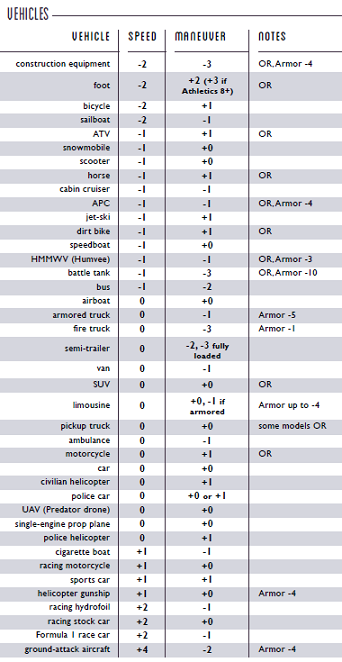 Have a nice big table of vehicles. OR = off-road. NEXT: Guns.
|
|
|
|
LatwPIAT posted:I don't, by itself, mind that the book references things I don't know. I just find the examples used to be particularly striking in their obscurity; a "significant pop-culture figure" is someone who until reading M20 I had never heard of. Geronimo is rated above Elvis and Batman. These examples are supposed to provide context and guidelines, but to me they fail to do so. I know who Grumpy Cat is, I don't know who Janis Joplin is. I know more about Elvis than Geronimo. This makes it very hard for me - and I reckon I'm not alone in this - to determine where on this scale something falls. Is Fritiof Nansen an obscure 1-dot legend, or a major 4-dot legend? You're a non-American citizen, aren't you? Geronimo was the leader of an Apache tribe, who waged a small war against both Mexican and American armies throughout the Southwest for almost 30 years. They even captured him, put him on a reservation, to which he escaped and continued to wage war against the U.S., until they captured him again and put him on a military base. He became famous after his capture, because he represented the disappearing West, and he lived out until the beginning of the 20th century. The "skull" in the exclusive Skull and Bones society at Yale is rumored to be his skull, stolen by Prescott Bush (the father and grandfather of two American presidents). American airborne troopers, because of the early Native American cultural influence on the 101st Airborne, use his name whenever they make jumps. There's places he stalyed at during his campaign that have since been named after him. He's probably akin to Che Guevara, for a more international analogy, an iconic rebel who stuck to his ideals. Janis Joplin was an American songstress during the 1960s. She's pretty much a contemporary of Jimi Hendrix, having performed at Woodstock and, also like Hendrix, dying young from a drug overdose pretty much around the same time.
|
|
|
|
-
Man, TORG really was the ur-game of the 1990s, embodying all of that decade's design pathologies. Including, in this case, the tradition of soaking up pagecount and wordcount with bad, just-above-fanfic quality, in-universe fiction meant to illustrate some feature of the setting or rules.
|
|
|
|
Geronimo is who you are thinking of when you think of a defiant Native American chief. You may not know the name but his influence on cultural perception is enormous.
Terrible Opinions fucked around with this message at 17:01 on Jan 15, 2016 |
|
|
|
LatwPIAT posted:I don't, by itself, mind that the book references things I don't know. I just find the examples used to be particularly striking in their obscurity; a "significant pop-culture figure" is someone who until reading M20 I had never heard of. Geronimo is rated above Elvis and Batman. These examples are supposed to provide context and guidelines, but to me they fail to do so. I know who Grumpy Cat is, I don't know who Janis Joplin is. I know more about Elvis than Geronimo. This makes it very hard for me - and I reckon I'm not alone in this - to determine where on this scale something falls. Is Fritiof Nansen an obscure 1-dot legend, or a major 4-dot legend? I think the issue is that Brucato is letting his prejudices show again. Geronimo is an Apache folk hero who resisted both the Mexicans and the Americans, of course he's more important than Elvis and Batman. But putting him on the same level as Red Riding Hood just seems... wrong somehow. Why are fictional characters even *on* that list?
|
|
|
|
FMguru posted:-
|
|
|
|
Weirdly, some of the Bloodshadows books were actually fairly decent, as far as 'magic noir potboiler' goes, but they had different writers than the TORG books, I think.
|
|
|
|
Evil Mastermind posted:You should have seen the novels. Sadly, the second and third novels of the original trilogy seem to have been lost to the ages, but a few of the other novels are available in PDF format. Like the one where the Gaunt Man tells his loving life story.
|
|
|
|
Kurieg posted:In Beast the mechanical bits, such as they are, are somewhat well put together. The Atavisms and Nightmares are really good and evocative. But the fluff put together around those mechanics is what kills it. It's one of those things where you think a competent writer could probably come in and salvage it given the opportunity, except a competent writer was given that opportunity, If the color choices for the text/backgrounds in the book itself didn't make huge sections borderline-to-actually-illegible, it'd make for a pretty good write-up candidate for this thread.
|
|
|
|
FMguru posted:Bad tie-in novels were a 1980s thing (Dragonlance and Forgotten Realms) that stretched into later decades. Filling up game books with bad fiction was a 1990s thing, and TORG looks like it was a big innovator there, like it was for so many other terrible 1990s RPG design trends (metaplot, supplement treadmill, unkillable key NPCs, etc.) Technically, yes, the High Lords were "unkillable" since they had thousands upon thousands of possibility points, not to mention that the Darkness Devices let them get around the whole "you can only spend one possibility per roll" restriction. Even so, they still had full stat blocks. Even though apart from Mobius the PCs would probably never actually meet any of them. Also the original novel trilogy is the lead in to the base set. It's not a tie-in, it's the backstory. The books would reference NPCs and events from the trilogy with the assumption that you read them and remembered everything that happened, because very rarely would they summarize metaplot events after the fact. For instance, a lot of early books refer to something called the "Miracle of Sacramento". I've been a Torg fan since the beginning, and I never knew what this was or what book it was in until literally this week when I did the last post for Nippon Tech and I stumbled across it in the first Infiniverse Update. In conclusion: 
|
|
|
|
I thought you meant sheriff Geronimo MST3K 10.08 By popular demand fucked around with this message at 17:31 on Jan 15, 2016 |
|
|
|
Don't forget that the game designer of the "Five Realms" RPG-within-an-RPG that was based on TORG and TORG's game designer was actually the anti-Torg, Apeiros! ...Actually, do. Do forget that.
|
|
|
|
unseenlibrarian posted:Don't forget that the game designer of the "Five Realms" RPG-within-an-RPG that was based on TORG and TORG's game designer was actually the anti-Torg, Apeiros! The only self-insert Gary Stu in history who doesn't actually do anything. At all.
|
|
|
|
In Nomine: I'm Cool, You Can Tell Because Of Patchwork Ofanim, AKA the Thrones or the Wheels, are "the Easy Riders of the celestial realm." We know this because they won't stop telling us. Their resonance is for motion, and they never stop. They hate inaction, and they are the Choir most capable of short-term results. Their nature guides them to the fastest path to anywhere, and they intuitively understand the terrain. They're whimsical, erratic and insane angels, even by celestial standards. They have very short attention spans, and an Ofanite "likes to watch television as he paces, one hand clenched on the remote control as channels speed past, ranting loudly and gesturing like an amphetamine-dosed spider monkey." Malakim tend to have trouble with Ofanim - they can't get used to the frivolity that the Ofanim seem to love. Ofanite dissonance is inaction. If an Ofanite has the chance to indulge their mobie nature, they must. Imprisonment, binding or inability to act terrify Ofanim, and even more terrifying is being able to act and not doing so. Inaction in the face of need is gravely dissonant. Ofanim appear as giant wheels of holy flame, flying through the sky. Their human vessels tend to be manic, wide-eyed and gaunt, poorly kept and almost radiating heat. They have mad, fearless eyes. Ofanim serve as messengers and border-jumpers, "celestial workaholics in the ultimate high-pressure office." Other Choirs respect them, but also pity them. Ofanim see themselves as percussion - anything from random cymbal crashes to 140 bpm European techno. Mechanically, Ofanim have three different ways to apply their resonance. The CD of a successful resonance can be added to the TN for any Agility-based roll, skill or stat. However, if they then fail the modified roll, they gain dissonance if the CD of the failed roll is 6 or higher. They also gain dissonance if they use their resonance again before using the bonus. Seccond, an Ofanite can add the CD of a successful resonance to the TN of any Area Knowledge roll, sensing the direction to any general site ('the nearest convenience store') or specific place ('the nearest gas station that sells detail') as long as those locations exist within the public consciousness - they're no Cherubim, to precisely track specific objects. Lastly, an Ofanite can use their resonance to travel (CD) miles in a single minute while in celestial form, rolling for each minute of travel.  Elohim, AKA Dynamis or the Powers, are the calm, dispassionate middle of the celestial hierarchy. Their nature is balance of thought and feeling. They resonate with emotion and objectivity, allowing them to understand the minds of those they look upon. They can use this to predict how people will react, and it is only their reserved natures that allow them to profit from it - they never take sides, denying themselves personal passions in order to serve the Symphony. They conflict with no one, holding bias towards none, and other Choirs respect them, though they often feel the Elohim focus too much on the big picture. More outspoken angels often find them boring and passionless, frustrating in their refusal to be subjective. The reason is that subjectivity is dissonant. Elohim form opinions from fact and observation, though of course they often debate the inherent subjectivity of observation, but they refuse to allow themselves to act on their opinions. They feel emotions but it is dissonant for them to act on them. When an Elohite alters the Symphony out of selfishness or desire, they step closer to damnation. Elohim are the advisors of Heaven. They aren't above getting their hands dirty, despite their calm and dispassionate natures. They aren't uncomfortable in bars or brothels - they don't judge places. You are where you are. On the celestial plane, they appear as vaguely human figures with smooth, androgynous features and hairless heads. They Fall only rarely, cherishing their objectivity and refusal of passion, but their heartlessness can itself lead them down the wrong path. They seldom show their passions, but identify with beels, chimes and xylophones. Mechanically, Elohim resonate for emotion, sensing the feelings their target has at the time. With CD 1, they know the target's current broad emotional state. At CD 2, they also know the single strongest emotion the target is feeling. At 3, also the motivation of that emotion. At 4, you get the two strongest emotions and their motivations. At 5, you also know how the target would react in that moment to any one action. At CD 6, two actions. An action is defined as anything that could be done in no more than a single combat round. This isn't precognition, the game notes, "but it's good enough for rock and roll."  Malakim, AKA the Kings or the Virtues, are the purity of Heavenly honor and wrath. They are often arrogant, tyrannical and cruel, but they are angels. Their resonance is for honor, and their honor matters more to them than their lives. They can see a human's purity of nature and virtue of principle - how selfish and selfless people are, and if they try to rise above or sink below. And, uh, apparently they tend to kill those they find unworthy. Everything is exceptionally serious to Malakim, and they insist on honor in those around them. While they don't have time to straighten out everyone, they also don't shrink back from doing so if they must. There's a war on, you know. The Ofanim accept their seriousness the worst, and often like to give them a metaphorical wedgie. The dissonance of the Malakim is dishonor. No Malakim has ever Fallen, and they claim they are incapable of it, but some say it's just that they police themselves heavily. Either way, every Malakite has a personal code of honor that they follow and expect others to follow. They all have four oaths, and many have more. Two of these oaths are constants. First, a Malakite can never suffer an evil to live if it is their choice. They can lie about showing mercy, though! Second, a Malakite can never surrender in a fight or allow themselves to be captured by the armies of Lucifer. Death is preferable - it's not like Malakim can suffer trauma. The other two required oaths are defined by the Malakite. In celestial form, Malakim appear as shadowy figures, with huge black wings. They tend towards simple, utilitarian vessels, but like leather. Especially leather made from animals they've killed personally. Malakim are ruthless, but their motives are unquestionable. Other angels watch them carefully and try to stay on their good sides, though. Malakim who care about personification think of themselves as heavy, strong drums. Mechanically, a Malakite can sense someone's personal honor. At CD 1, they know most noble or ignoble thin the target's done that week by the target's standards. The GM chooses which. At CD 2, they know both. At CD 3, they know the three most noble or ignoble acts of the last year, by the target's standards. At CD 4, they know both the three most noble and ignoble acts of the last year. At CD 5, they know the target's greatest virtue and worse sin. At CD 6, they know the greatest potential the target has for good or evil - and they can automatically detect a Balseraph if they used this on one. Not other demons, however. Next time: What do you get for the angel who's everyone?
|
|
|
|
Young Freud posted:You're a non-American citizen, aren't you? Yup. It makes a lot of the references to American things as if they were universal stand out to me. I'm less good at picking up when Western things are referred to as if they were universal, of course. I know more about Shaka Zulu and Guy Fawkes (both examples of 3-dot Legends) than I knew about Geronimo. I knew that Geronimo was a real person, that he was Native American, and that in US culture people sometimes shout his name when throwing themselves into danger - but beyond that I was clueless. My point, and I apologise if I made this badly, is that there's a lot of presumptions in the book about the dominance of US culture; Geronimo, who probably is a big deal in the US, is treated as if he's some universal figure of greater repute than Elvis (which, although also American, is far, far more famous). To me the emphasis placed on US culture reads like a statement that all these pretty US-specific things are somehow important enough that they have immense metaphysical weight - which gets particularly weird when said weight is supposed to come from how well known they are in the first place. Maybe I'm completely wrong though, and I'm just really ignorant of all these historical characters everyone knows? Kurieg posted:I think the issue is that Brucato is letting his prejudices show again. Geronimo is an Apache folk hero who resisted both the Mexicans and the Americans, of course he's more important than Elvis and Batman. But putting him on the same level as Red Riding Hood just seems... wrong somehow. Why are fictional characters even *on* that list? Brucato writes "Our media age manufactures legends, so your model could be a pop-culture character, though the power of such legends doesn’t run very deep.", which really is another pet peeve of mine. He again and again seems to assign some greater metaphysical value to things because of their, to pick a term, respectability. Pop-culture isn't respectable, so it matters less than history and historical legends. Serious religions that can claim some lineage to the past have more metaphysical clout than post-modern religions. Yet, at the same time, the book is littered with pop-culture references strewn around as if give weight to his statements. It almost feels like he tries to ape the style of post-modern authors without understanding the message; "Minnie Mouse is Mickey Mouse's girlfriend" has no greater value than "the Knights Templar were established in 1120". FMguru posted:Bad tie-in novels were a 1980s thing (Dragonlance and Forgotten Realms) that stretched into later decades. Filling up game books with bad fiction was a 1990s thing, and TORG looks like it was a big innovator there, like it was for so many other terrible 1990s RPG design trends (metaplot, supplement treadmill, unkillable key NPCs, etc.) Bad tie-in novels were also massively more profitable than the RPGs they were based on, at least for D&D, where if I recall correctly, the Dragonlance novels completely eclipsed the actual RPG, and the Dragonlance RPG material basically became a way for TSR to get people to start buying the books. (I suspect this is why there's so much bad fiction in 1990's game books; it's an attempt to get people to want to read more about the characters, so you can start selling novels to them.)
|
|
|
|
LatwPIAT posted:Yup. It makes a lot of the references to American things as if they were universal stand out to me. I'm less good at picking up when Western things are referred to as if they were universal, of course. I know more about Shaka Zulu and Guy Fawkes (both examples of 3-dot Legends) than I knew about Geronimo. I knew that Geronimo was a real person, that he was Native American, and that in US culture people sometimes shout his name when throwing themselves into danger - but beyond that I was clueless. My point, and I apologise if I made this badly, is that there's a lot of presumptions in the book about the dominance of US culture; Geronimo, who probably is a big deal in the US, is treated as if he's some universal figure of greater repute than Elvis (which, although also American, is far, far more famous). To me the emphasis placed on US culture reads like a statement that all these pretty US-specific things are somehow important enough that they have immense metaphysical weight - which gets particularly weird when said weight is supposed to come from how well known they are in the first place. I hate to tell you this, but Elvis is way bigger than Geronimo in the US, too. Most people know the name. They know literally nothing else about the guy, and may in fact not realize that it is a name. Native Americans don't generally get remembered much in mainstream American culture. (Hell, Custer isn't reviled by mainstream American culture.)
|
|
|
|
LatwPIAT posted:Bad tie-in novels were also massively more profitable than the RPGs they were based on, at least for D&D, where if I recall correctly, the Dragonlance novels completely eclipsed the actual RPG, and the Dragonlance RPG material basically became a way for TSR to get people to start buying the books. (I suspect this is why there's so much bad fiction in 1990's game books; it's an attempt to get people to want to read more about the characters, so you can start selling novels to them.) And as much as I love to make fun of 1990s RPGs, those things (metaplots, iconic NPCs that do everything, tie-in novels, slowly teasing out setting details, walls of splatbooks, etc.) were legitimate efforts to try and get around the core economic problem with RPGs (the way that a single group can play for year without buying anything more than a single set of corebooks)
|
|
|
|

|
| # ? Apr 19, 2024 22:24 |
|
Thank you, Cheese Dudes, for a gratuitous reference to one of my favorite TMBG songs. Because yes, I'm a huge nerd (shocker).
|
|
|

